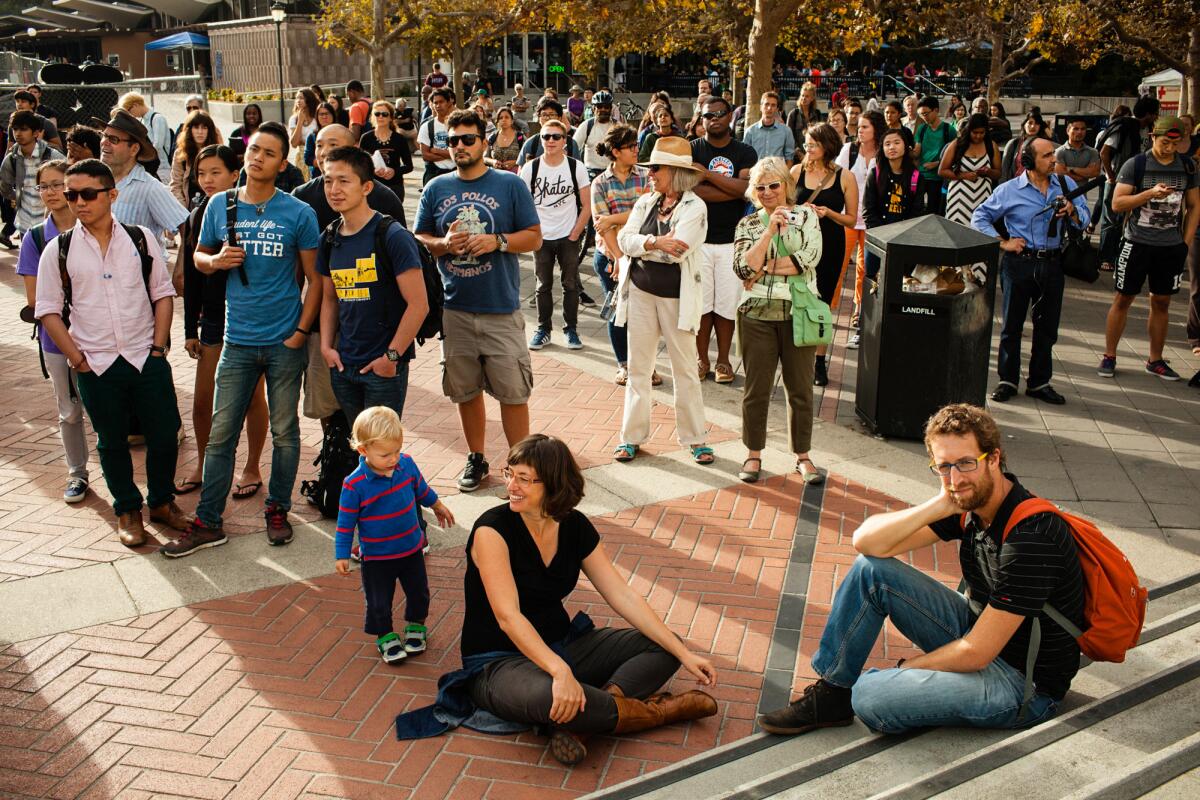Op-Ed: Donât mock or ignore studentsâ lack of support for free speech. Teach them

Spectators gather at an event honoring the 50th anniversary of the Free Speech Movement at Sproul Plaza on the University of California, Berkeley campus in 2014.
Teaching a freshman seminar on freedom of speech on college campuses has made us aware of the urgent need to educate the current generation of students about the importance of the 1st Amendment. From the beginning of our course, we were surprised by the often unanimous willingness of our students to support efforts to restrict and punish a wide range of expression. Not a single student in the class saw any constitutional problem with requiring professors to give âtrigger warningsâ before teaching potentially disturbing material.
Surveys across the country confirm that our students are not unique. According to the William F. Buckley Jr. Program at Yale, 72% of students support disciplinary action against âany student or faculty member on campus who uses language that is considered racist, sexist, homophobic or otherwise offensive.â Too few students grasp that one personâs offense can be anotherâs expression of truth to power.
Young peopleâs support for freedom of speech has waned in part because of their admirable desire to create an educational environment where all can thrive. Our students or their friends have experienced the psychological harms of hateful speech or bullying more than they have experienced the social harms of censorship or the punishment of dissent.
Simply telling students to toughen up isnât persuasive. Moreover, they were born long after the civil rights movement and anti-Vietnam War protests that gave their elders direct experience with the need for free expression. It is their education thatâs lacking.
History demonstrates that when we give officials broad powers to restrict or punish speech considered hateful, offensive or demeaning, that power is inevitably abused. Unpopular speakers are victimized, and legitimate opinion silenced. Over the course of U.S. history, officials censored or punished those whose speech they disliked: abolitionists, labor activists, religious minorities, communists and socialists, cultural critics, gays and lesbians, demonstrators and protesters of all stripes.
The students were surprised to learn that people went to prison for speech criticizing the draft during World War I, or for teaching or espousing communism during the 1920s and 1930s and in the McCarthy era. The effect of the 1st Amendmentâs strong protections for âdangerousâ and âoffensiveâ speech allowed oppressed and marginalized groups to challenge indecency laws, segregation, patriarchy and declarations of war.
Learning what kinds of expression can be constitutionally punished gives students a realistic sense of how speech can be regulated on public university campuses.
Another key lesson was that censoring intolerant or offensive speech can be all but impossible to manage without threatening legitimate debate. There are those who will take offense at anti-Zionist speech and at pro-Zionist speech, at the rhetoric of Black Lives Matter and the demands of racial equality, at advocacy for LGBT rights and for religious beliefs that run counter to those rights. Our students came to realize that there was no way to create a âsafe spaceâ on campuses where students could be free from one set of offenses without engaging in massive censorship, and perhaps creating another kind of offense.
Of course, freedom of speech is not absolute. Incitement of illegal activity, defamation, true threats and harassment are not protected by the 1st Amendment. Learning what kinds of expression can be constitutionally punished gives students a realistic sense of how speech can be regulated on public university campuses.
For speech that students find offensive but that does not fall within these categories, they must also consider one of the most hard-won lessons of free speech law: Often the best remedy for hateful speech is more speech, not enforced silence.
By challenging and contesting offensive speech students learn to hone their voices in defense of their values, an important skill in a diverse democratic society. By contrast, punishing expression often achieves little except to create martyrs.
At the beginning of the semester we took a vote in the class: Who would agree that the University of Oklahoma was right to expel students who had led a racist chant in a bus on the way to a fraternity event? All hands were raised. By semesterâs end, many, but not all, had changed their minds, and those who still supported the university did so with a much more sophisticated understanding of the balance of issues.
Rather than mock students or ignore their concerns, we need to make sure they understand the context of the Constitutionâs free speech guarantees. At stake is not merely the climate on our campuses, but the longevity of the great social benefits associated with the rise of modern free speech traditions.
Howard Gillman is chancellor and professor of law, political science and history at UC Irvine. Erwin Chemerinsky is founding dean and a professor at the UC Irvine School of Law.
Follow the Opinion section on Twitter @latimesopinion and Facebook
More to Read
A cure for the common opinion
Get thought-provoking perspectives with our weekly newsletter.
You may occasionally receive promotional content from the Los Angeles Times.










